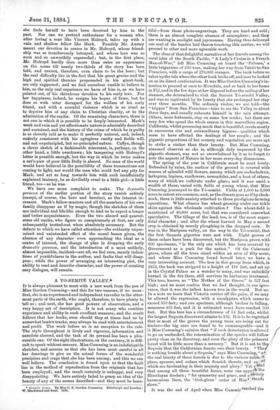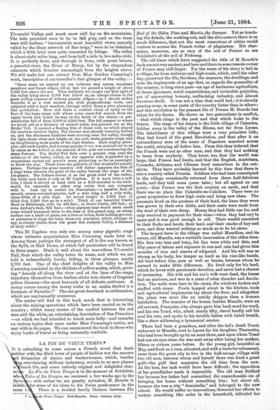A YO-SEMITE VALLEY.*
Ix is always pleasant to meet with a new work from the pen of Miss Gordon Cumming—and this for two reasons, if no more : first, she is an experienced and independent traveller in the utter- most parts of the earth, who ought, therefore, to have plenty to -tell us ; and next, she has good powers of observation, and a very happy art of description. It is not many who combine experience and ability in such excellent measure; and the result follows that her books, even should they at times lead us by somewhat beaten tracks, may always be read with entertainment and profit. The work before us is no exception to the rule. The style throughout is lively and vigorous, information and anecdote abound, and the task of its perusal has been a plea- surable one. Of the eight illustrations, on the contrary, it is diffi- -cult to speak without censure. Miss Cumming is an indefatigable sketcher, and assures us that she has been most careful in all her drawings to give us the actual forms of the wonderful precipices and crags that she has been among; and this we can well believe. The conclusion is forced upon us that the fault lies in the method of reproduction from the originals that has been employed ; and the result certainly is unhappy, and very disappointing. We have entirely failed to grasp an idea of the beauty of any of the scenes described—and they must be beau- • Granite Crags. By Hiss C. F. Gordon Cumming. Edinburgh and London : W. Blaokvtood and Sons. 1834.
tiful—from these photo-engravings. They are hard and cold; there is an almost complete absence of atmosphere; and they are wanting in sunlight and joyousness. Having thus delivered our soul of the burden laid theron touching this matter, we will proceed to other and more agreeable work.
The close of that delightful narrative of her travels among the coral isles of the South Pacific, "A Lady's Cruise in a French Man-of-War," left Miss Cumming on board the Paloma,' a little brigantine of 230 tons, making her way from Tahiti to San Francisco, with a cargo of 270,000 oranges. The book before us takes up the tale where the other book broke off, and may be looked on as its direct continuation. It was Miss Gordon Cumming's in- tention to proceed at once to Honolulu, and so back to her home in Fiji, and in the few days at her disposal before the sailing of her steamer, she determined to visit the famous Yo-semit4 Valley, and was so captivated by its beauty that she prolonged her stay over three months. The ordinary visitor, we are told—the " tripper " from San Francisco—tries to see the Valley in about three days, and usually exhausts himself in the vain attempt. Others, more fortunate, stay on some few weeks; but there are very few who spend the whole season in this marvellous region. California, whilst possessing much that is beautiful, revels mostly in enormous size and extraordinary bigness—qualities which seem to have affected the dealings of her people ; and the gigantic proportions of her scenery and vegetation are more apt to strike a visitor than their beauty. But Miss Cumming, seasoned observer as she is, although duly impressed by the gigantic element, was not so overwhelmed by it as to forget to note the aspects of Nature in her more every-day dimensions.
The spring of the year in California must be most lovely. Refreshed by rains, the surface of the ground is covered with masses of splendid wild flowers, among which are eschscholtzia, larkspurs, lupines, sunflowers, nemophilas, and a host of others, many of which we cultivate under glass ; and it was amid a wealth of these, varied with fields of young wheat, that Miss Cumming journeyed to the Yo-semite5. Fields of 1,000 to 5,000 acres in extent are common; and, as the climate goes as if by clock- work, there is little anxiety attached to these prodigious farming operations. What chance has wheat-growing under our fickle skies against this wholesale cultivation P One wheat-field is mentioned of 40,000 acres, but that was considered somewhat speculative. The tillage of the land, too, is of the most super- ficial character ; and after the wheat harvest in May a second crop is obtained by merely ploughing-in the dropped corn. It was in the Mariposa valley, on the way to the Yo-semit6, that the first Sequoia gigantea were met with. Eight groves of these cedars have been discovered, but the Mariposa grove, with 600 specimens, " is the only one which has been reserved by Government as a park for the nation." Of the Calaveras grove, where all the trees stand within an area of fifty acres, and where Miss Cumming found herself later, we have a very interesting account. The tree in this group from which, in 1854, the bark was stripped to a height of 116 feet, and set up in the Crystal Palace as a wonder to many, and was unluckily burned in the fire there, still survives its barbarous treatment. This tree, known as " The Mother of the Grove," is 327 feet high; and we must confess that we had thought, in our igno- rance, that it was the tallest known tree in the world. But no. In a note we learn that Victoria carries off the palm, if we may be allowed the expression, with a eucalyptus, which seems to exceed 350 feet; and one specimen, although broken in falling, measures 435 feet, and it is estimated must have reached 500 feet. But this tree has a circumference of 54 feet only, whilst the largest Sequoia discovered attains to 132. It is to be regretted that in most of the groves the young trees are being cut for timber—the big ones are found to be unmanageable—and it is Miss Cumming's opinion that " if such devastation is allowed to go on unchecked, the extermination of the species will follow pretty close on its discovery, and soon the glory of the primeval forest will be little more than a memory." But it is not to th Sequoia that the Californian forests owe their beauty. "The
is nothing lovable about a Sequoia," says Miss Cumming, " the real beauty of these forests is due to the various noble pines, spruces, and cedars which flourish therein, and ea of which are fascinating in their majesty and glory." Yet 17ad that among all these beautiful forms, none can apprA the
Himalayan deodara ; " for symmetry and grace, and a aisitely harmonious lines, the God-given' cedar of Hire' stands alone."
It was the end of April when Miss Commie hodtheeac Yo-semite Valley, and much snow still lay on the mountains. The falls promised soon to be in full p'ay, and as the trees were still leafless, " innumerable most beautiful views, scarcely veiled by the filmy network of fine twigs," were to be obtained, which a little later were quite concealed by foliage. The valley is about eight miles long, and from half a mile to two miles wide. It is perfectly level, and through it flows, with great leisure, a peaceful river, the River of Mercy, fed by the stupendous cataracts which thunder unceasingly from the heights above. 'We will make but one extract from Miss Gordon Cumming's work, descriptive of our traveller's first glimpse of the valley :—
" Once more we started on our toilsome way across mountain meadows and forest ridges, till at last we gained a height of about 7,000 feet above the sea. Then suddenly we caught our first sight of the valley lying about 3,000 feet below ns, an abrupt chasm in the great rolling expanse of billowy granite ridges,—or, I should rather describe it as a vast sunken pit, with perpendicular walls, and carpeted with a level meadow, through which flows a river gleaming like quicksilver. Here and there a vertical cloud of spray on the face of the huge crags told where some snow-fed stream from the upper levels had found its way to the brink of the chasm—a per- pendicular fall of from 2,000 to 3,000 feet. The fall nearest to where we stood, yet at a distance of several miles, was pointed out as the Bridal Veil. It seemed a floating film of finest mist, on which played the loveliest rainbow lights. For the sun was already lowering behind us, and the afternoon shadows were stealing over the valley, though the light shone clear and bright on the cold, white granite crags, and on the glittering snow-peaks of the high Sierras. Each mighty preci- pice, and rock-needle, and strange granite dome, was pointed out to us by name as we halted on the summit of the pass ere commencing the steep descent. The Bridal Veil fails over a granite crag near the entrance of the valley, which, on the opposite side, is guarded by a stupendous square-cut granite mass, projecting so far as seemingly to block the way. These form the gateway of this wonderful granite prison. Perhaps the great massive cliff rather suggests the idea of a huge keep wherein the genii of the valley braved the siege of the Ice-giants. The Indians revere it as the great chief of the valley, but white men know it only as El Capitan. If it must have a new title, I think it should at least rank as a field-marshal in the rock- world, for assuredly no other crag exists that can compare with it. Just try to realise its dimensions,—a massive face of smooth, cream-coloured granite, half a mile long, half a mile wide, three-fifths of a mile high. Its actual height is 3,300 feet (I think that 5,280 feet go to a mile). Think of our beautiful Castle Rock in Edinburgh, with its 434 feet ; or Dover Castle, 469 feet ; or even Arthur's Seat, 822 feet ;—what pigmies they would seem could some wizard transport them to the base of this grand crag, on whose surface not a blade of grass, not a fern or lichen, finds holding-ground, or presumes to tinge the bare, clean-cut precipice, which, strange to say, is clearly visible from the great San Joaquin Valley, a distance of sixty miles."
This El Capitan was only one among many gigantic crags whose intimate acquaintance Miss Cumming made later on. Among these, perhaps the strangest of all is the one known as the Split, or Half Dome, of which full particulars will be found in these pages. Much is said about the marvellous Yo-semite Fall, from which the valley takes its name, and which we, are told is indescribably lovely, falling, in three plunges, nearly 2,700 feet. One of the chief delights of the valley to Miss Cumming consisted in the thickets of yellow azalea, which, grow. ing " densely all along the river and at the base of the crags, transform themselves from leafless sticks into sheets of fragrant yellow blossom—the most heavenly of all delicate perfumes. A sunny corner among the mossy rocks in an azalea thicket is a foretaste of Paradise !" The one great drawback is rattlesnakes, which are unpleasantly numerous.
The reader will find in this book much that is interesting about the mining operations which have been carried on in the country ; whilst many stories of the conflict between the red men and the white, an entertaining description of San Francisco —on which we had intended to touch more fully—and remarks on various topics that came under Miss Cumming's notice, are met with in its pages. We can recommend the book to those who enjoy books of travel as being eminently readable.



































 Previous page
Previous page